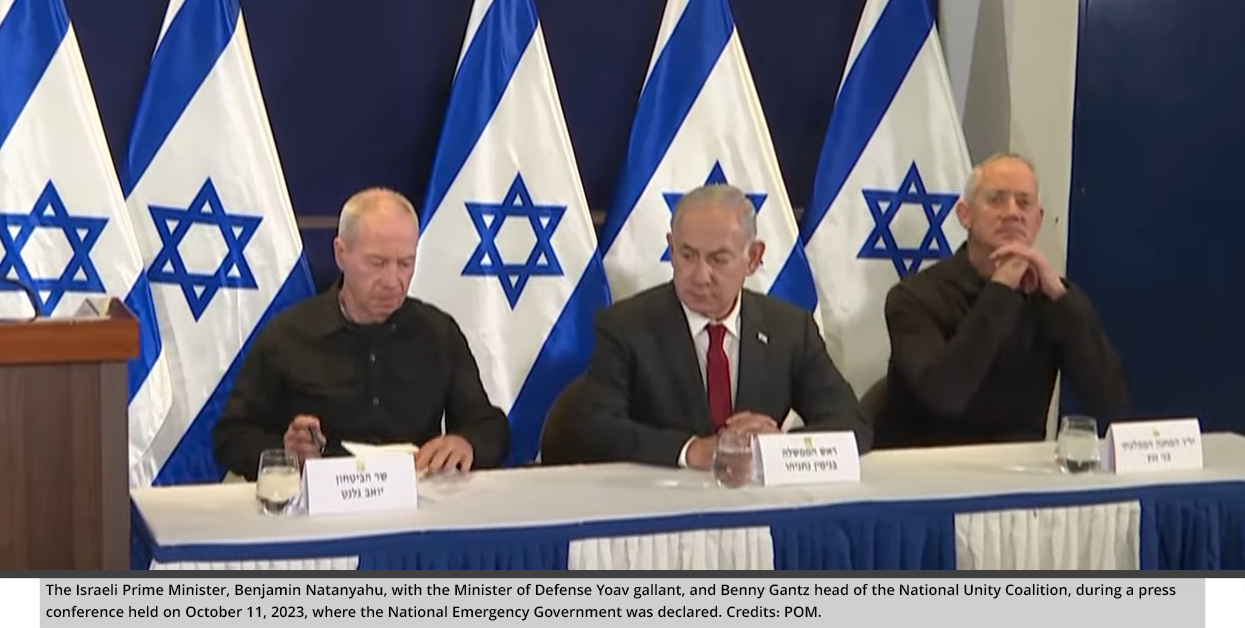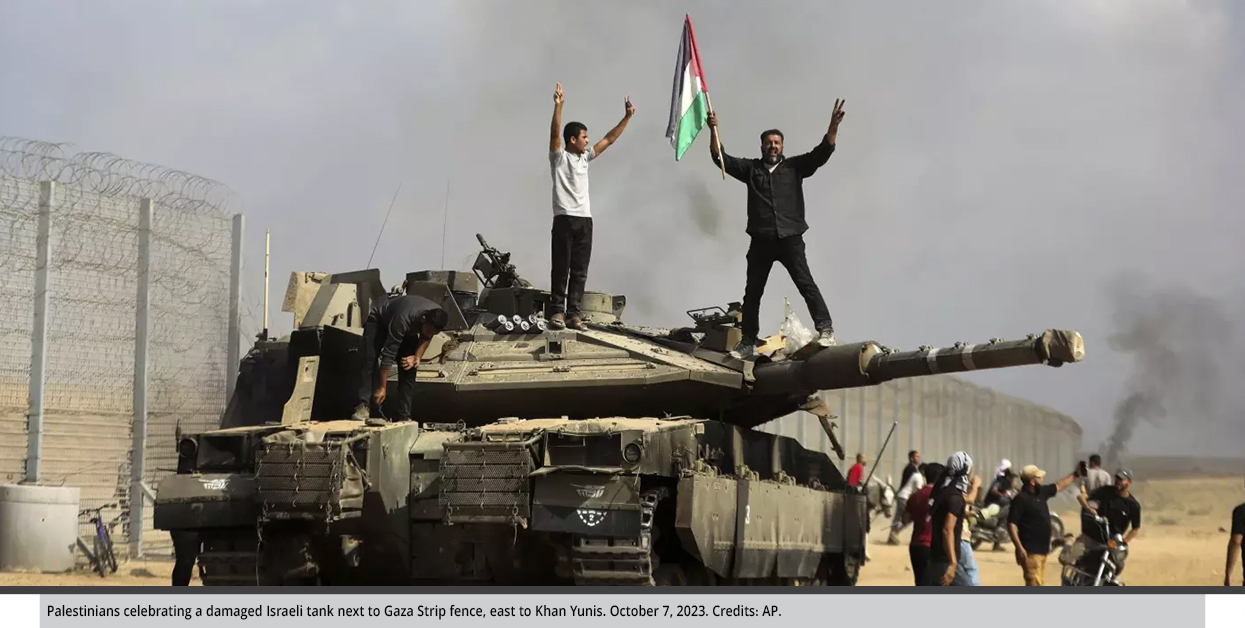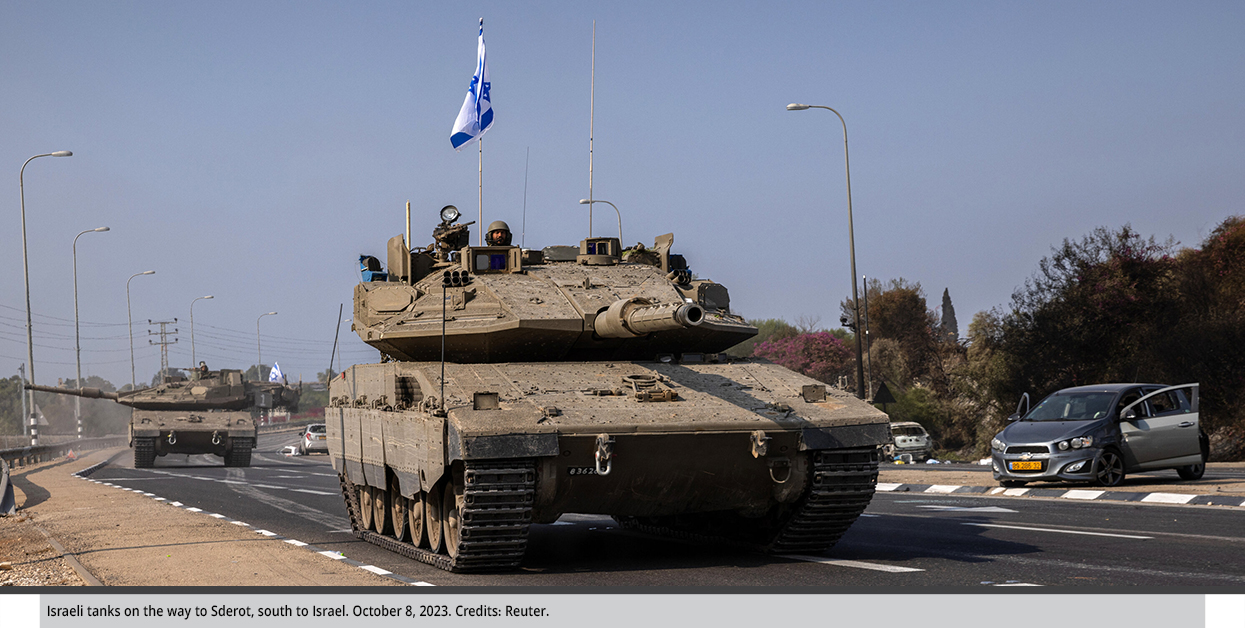Position Assessment: Potential Pathways of Conflict between Hamas and Israel
some of days of war have passed, yet the possible consequences remain enigmatic to observers, as this conflict presents multiple potential outcomes at the Israeli, Palestinian, regional, and international levels. This position assessment aims to explore the most likely scenarios for future developments.
by STRATEGIECS Team
- Release Date – Oct 12, 2023

On October 7, 2023, Hamas initiated Operation Toofan Al-Aqsa (Arabic for Al-Aqsa Flood) by launching a massive rocket attack and ground offensive on Israeli settlements near Gaza and Ashkelon. This operation was conducted in coordination with other armed factions, notably the Al-Quds Brigades of the Islamic Jihad movement. In response, Israel declared a “state of war” for the first time since 1973 and initiated Operation Iron Swords to target Hamas‘s infrastructure in the Gaza Strip. After six days of hostilities, the outcomes of this conflict remain uncertain, as it encompasses multiple dimensions at the Israeli, Palestinian, regional, and international levels. Therefore, this paper seeks to examine the most plausible scenarios for the conflict’s dynamics in the coming days and, potentially, weeks.
Toofan al-Aqsa: Action and Motivations
Operation Toofan al-Aqsa, executed by Hamas, was a comprehensive assault involving land, sea, and air forces. The operation saw Hamas fighters penetrating the border wall that separates the Gaza Strip from the surrounding Gaza Envelope settlements. Utilizing gliders and speedboats, they infiltrated up to 40 km into the Envelope areas and settlements, capturing hundreds of Israeli civilians and soldiers. Simultaneously, a large-scale rocket attack targeted the settlements of the Gaza Strip, Ashkelon, and later extended to Beersheba, Tel Aviv, and Jerusalem.
In its initial stages, Operation Toofan al-Aqsa surprised observers due to its scale, innovative penetration methods, precise intelligence information regarding military and civilian targets, the military equipment used by the attackers, the level of pre-operation training, and the ability to maintain stable communication with the central operations room.
An escalation of conflict in the Gaza Strip or the West Bank was expected given the heightened tensions between Palestinians and Israelis. This was further exacerbated by the Israeli government’s stringent policies towards detainees in Israeli penitentiaries and ongoing tensions at the Al-Aqsa Mosque.
The following are seven of the multiple motivations and justifications Hamas had for executing this operation.
1- Attempting to Alter the Current Status Quo
The scale of the assault within Israel’s borders signifies that Hamas aimed not merely to disrupt the state of deterrence with Israel but to transform the prevailing status quo entirely. Hamas seeks to establish a novel reality in its conflict with Israel, one that extends beyond the geographical confines of the Gaza Strip or the West Bank as the sole arenas of combat with Israel. This involves a gradual encroachment into Israeli territory, leading to a potential change in the settlement map, particularly within the Gaza Envelope.
2- Amplifying the Perception of Hamas in the West Bank
recent years, Hamas has been striving to augment its influence in the West Bank, aiming to diminish the role of the Palestinian Authority (PA) within the region. The preceding months have witnessed an increase in the efficacy of Hamas’s presence and operations in the West Bank, as it endeavors to construct a military infrastructure. Alongside this, Hamas has taken responsibility for numerous attacks on settlers, both within West Bank settlements and deep within Israel’s borders.
3- Employing the Tactical Evolution of Hamas
This operation demonstrates Hamas’s progression in terms of military strategy, warfare planning, and the diversification of its arsenal, which now includes aerial assets such as gliders and drones. Furthermore, it highlights Hamas’s ability to execute hit-and-run operations and seize control of Israeli military bases and equipment. This evolution follows a pattern observed in previous escalations between Hamas and Israel in the Gaza Strip, as well as through Hamas activities in the West Bank. The tactics employed by Hamas, with support from Iranian armed groups, are similar to those of the Iranian Revolutionary Guards.
.jpg)
4- Involvement of Israeli Military and Intelligence in Politics
Hamas, along with other Palestinian armed factions, Hezbollah, and groups affiliated with Iran have closely monitored the political and military discord within Israel over proposed judicial amendments. They have taken particular interest in the refusal of Israeli soldiers and reserve officers to join military service. Adversaries of Israel perceive such discord as a weakness in Israel’s military deterrence policy, thereby presenting an opportunity to challenge the perceived invincibility of the Israel Defense Forces (IDF).
5- Impacting the Progression of Arab-Israeli Normalization Agreements
The expansion of Arab-Israeli normalization is viewed as a matter of existential significance by Iran and the militant groups it backs, notably Hamas and al-Jihad al-Islami. The initiation of Operation Tofan Al-Aqsa coincided with widespread speculation about the imminent declaration of Saudi-Israeli normalization under U.S. patronage. This development is seen by Tehran as bolstering Israel’s presence and standing in the region, which would be to Iran’s detriment.
6- Anticipating Israeli Use of Previous Two Experiences
The infiltration of Hamas and other militant factions into Israel marks the third such incident this year. On March 16, an insurgent, believed to be a member of Hezbollah, breached the border from Lebanon into southern Haifa and detonated an explosive device at the Megiddo crossroad, an operation characterized as “intricate and complex.” On June 3, an Egyptian police officer infiltrated and eliminated three Israeli soldiers in a confrontation that spanned several hours.
7- The Issue of Prisoner Exchange
Despite secret negotiations facilitated by regional intermediaries between Hamas and Israel, no substantial progress has been achieved for several years. The issue of prisoners has consistently been a priority for Hamas, particularly following the capture in 2014 of two Hamas soldiers, Hadar Golden and Aaron Shaul.
Operation Iron Swords: Between a Domestic Front and Gaza Strip
During the initial stages of Operation Toofan Al-Aqsa, a profound sense of shock engulfed both the Israeli state and society. This was primarily a result of the intelligence community’s failure to predict and preempt the attack. It sent political institutions into disarray, and the Israeli army’s response was notably delayed. This was particularly striking because Hamas members managed to infiltrate Israeli territory in broad daylight through land, sea, and air routes. Footage emerged of Hamas members moving freely within Israeli borders without apparent restrictions, capturing hundreds of Israelis and transporting them to the Gaza Strip. These early moments, marked by significant loss of life and the capture of hundreds, played a pivotal role in shaping Israel’s multifaceted response to the operation, both immediately and in its aftermath. Below are the key aspects of Israel’s response.
1- Regaining Control on the Home Front
The Gaza Envelope became the primary battleground from the outset of the three-prong Hamas assault of land, air, and sea. Regaining control over the Gaza Envelope was considered a political, security, and military priority because ongoing Hamas activities within Israeli territory were viewed as a setback for both the Israeli government and its military forces. The initial shock, confusion, and lack of information about the extent of the infiltration and its consequences, along with a dearth of intelligence and on-the-ground information, resulted in a three-day delay before the Israeli army, on October 10, could declare its relative control over the areas adjacent to Gaza.
2- Reestablishing Dominance in Conflict
During the first three days of the conflict, before the Israeli military regained control over the peripheries of Gaza, its primary objective was to reestablish dominance over Hamas, which was consistently achieving successive breakthroughs. The Israeli defense mechanism operated reactively in response to these breakthroughs, a strategy that, if continued, could result in its military and intelligence sectors losing their strategic focus, leading to an escalation of loss of lives, property, and prisoners.
3- Enhancing Deterrence on the Northern Front
The initial assumption was that an operation of this scale was a direct manifestation of the “Unity of Arenas” strategy, with the expectation that regional military factions would participate, each playing its specific role. This was particularly true for Hezbollah, which had recently escalated its training exercises along the Lebanese-Israeli border, with a special focus on gaining control over the Galilee regions. Consequently, the Israeli military deployed additional ground forces to its border with Lebanon. Simultaneously, the United States announced the deployment of the Aircraft Carrier Strike Group USS Gerald R. Ford off the Israeli coast in the eastern Mediterranean.
.jpg)
4- Mitigating the Impact of the Initial Strike
The Israeli government’s declaration of a “state of war,” the first in nearly half a century, was a reaction to the shock and surprise that overwhelmed Israeli systems and society. This declaration essentially imposed a nationwide state of emergency, mobilizing the country’s economic, logistical, and societal resources in support of the military effort. It included the activation of approximately 300,000 reserve conscripts for active duty. Coupled with support from the United States and the Western world, this allowed Israel to designate the Gaza Strip as a military operation zone with little regard for humanitarian considerations, while attempting to diminish the capabilities of Hamas and al-Jihad al-Islami.
5- Considerations of Partisanship and Coalition
A significant number of perspectives, particularly within Israel, blamed the government coalition for the unfolding events. The Israeli government’s policies were seen as severely diminishing Palestinian aspirations for their independent state. Furthermore, the Israeli military and security establishment appeared strained due to domestic divisions. This was particularly evident when the Israeli government proposed judicial amendments despite numerous warnings about escalating violence indicators in the West Bank and Gaza Strip.
In light of these issues, and the perceived decline in the deterrent capability of the Israeli military, it is anticipated that the current Israeli government may not endure. In response, Israeli Prime Minister Benjamin Netanyahu called for the establishment of an emergency government; on October 11, opposition leader Benny Gantz, the head of the National Unity party, announced his participation in this emergency government.

Between “Toofan al-Aqsa” and “Iron Swords,” Where Will the War Head?
As we enter into the second week of this conflict, predicting the course of the days ahead remains a challenging and intricate task. The swift evolution of events (potentially including unprecedented developments), shifting circumstances, and emerging actors makes forecasting difficult. However, one thing remains clear: both direct and indirect participants in the war are influenced by a complex interplay of local, regional, and global factors. These elements will inevitably shape the trajectory of events. We can categorize the potential direction of this conflict into four primary pathways.
Pathway One: Israel Engages in a Prolonged Conflict
Several indicators suggest Israel’s firm determination to launch a ground operation within the Gaza Strip. This resolve is evident in the consecutive declarations made by Israeli political and military leaders. The exceptional mobilization of 300,000 reserve soldiers further underscores this commitment. Additionally, Israel’s intensive and sustained aerial bombardment of the Gaza Strip, which has significantly impacted various Hamas infrastructures and ministries, provides further evidence of this intention.
This pathway is supported by the following four factors.
1- The Israeli approach concurs that the substantial prisoner population necessitates undermining Hamas in order to secure their release. It is acknowledged that initiating negotiations with Hamas from a position of strength will be intricate, multifaceted, and challenging. The issue of Israeli prisoners may continue to serve as a strategic tool for the movement for many years to come.
2- In order to regain the trust of Israeli citizens in their institutions, the shock and loss experienced by Israeli society necessitates a military response proportional to the trauma’s magnitude.
3- Halting the war implies a need for accountability from Netanyahu and the Israeli government. This could lead to military and security establishments, as well as the public, pressuring for a change in government or a call for early elections, which the president might not win.
4- Ceasing the war without addressing the underlying issues may revert Israel back to square one, awaiting new significant operations. This situation is further complicated by the looming fears associated with the so-called “Unity of Arenas.”
Israel’s decisions are influenced by the following three factors.
1- A ground incursion into the Gaza Strip may involve urban and street warfare, potentially reducing the effectiveness of the Israeli army’s equipment and military superiority. This could lead to exhaustion and eventual withdrawal without clear results.
2- Prolonged wars contradict Israeli military tactics based on “blitzkrieg.” Historically, Israel has not engaged in long-term warfare due to the potential economic and social damage and losses it may incur.
3- A blitzkrieg ground invasion of the Gaza Strip by the Israeli army may not result in the liberation of prisoners or achieve a strategic defeat for Hamas, as evidenced by previous experiences such as the 14-day 2008 ground invasion or the 19-day 2014 invasion.
Given these considerations, Israel is likely to engage in a protracted yet intermittent ground conflict. This may involve qualitative operations within the Gaza Strip or limited incursions similar to those conducted in the West Bank. The objective would be to exhaust Hamas’s capabilities, gradually free prisoners, and avoid extensive street warfare operations. Such a strategy necessitates intelligence capabilities and continuous surveillance from air, land, and sea, with the Israeli army maintaining control of the conflict. The potential involvement of the U.S. Delta Force, formally known as 1st Special Forces Operational Detachment–Delta, may further support this approach. Meanwhile, initial assessments based on Hamas’s handling and securing of prisoners suggest that freeing hostages through a military operation could prove a challenging task.

Pathway Two: Heading Towards Ceasefire and Truce
The potential for ceasefires and pacification remains a constant in all wars and conflicts, regardless of their scale or context. This is especially relevant in the ongoing conflict between Hamas and Israel.
Several factors support the possibility of this pathway.
1- Warfare intensifies global challenges, particularly concerning energy price stability. European nations have been grappling with soaring energy costs since the start of the Ukrainian crisis in spring 2022. These economic difficulties may exacerbate with the war, leading to increased inflation rates.
2- America’s focus on the crisis in Ukraine may lead to a short-term inclination towards a ceasefire in the Gaza Strip. This is particularly likely because assisting Ukraine is depleting the U.S military munitions stockpile. Furthermore, the lack of bipartisan consensus on the government budget, along with the enactment of a temporary funding law, may complicate efforts to ensure adequate financial and military support for both Ukraine and Israel.
3- Middle Eastern nations, especially Arab countries, are advocating for appeasement to prevent further losses on both sides and to avert potential public backlash against Israel.
4- The diplomatic tour of U.S. Secretary of State Antony Blinken, including visits to Jordan and Israel, along with his announced intention to visit several other countries in the region, signifies an effort to harmonize regional stances with the goal of achieving a ceasefire.
Three factors continue to influence the two parties.
1- the conflicting parties remain staunchly against any form of dialogue or negotiation concerning prisoners, a significant factor that could potentially establish peace between them.
2- if Israel were to agree to a ceasefire, it could potentially undermine the reputation of its military institution, which has retaliated by escalating airstrikes, albeit without achieving tangible results.
3- if Hamas were to agree to a ceasefire, it could distort public perception, both within the Gaza Strip and the West Bank. This is because such a large-scale operation, coupled with the overstatement of its strategic objectives, has only resulted in increased destruction and a tighter siege on the Gaza Strip.
Considering these factors, discussions about a ceasefire are more likely to occur in the near term rather than the immediate future. Western nations continue to hesitate about pressuring Israel to cease hostilities, supported to conduct decisive operations against Hamas, operations that correspond with the extent of Israeli losses. However, once Israel manages to restore some of its reputation, international and regional initiatives advocating for a ceasefire may gain momentum.
Pathway Three: The Conflict Expands to New Fronts
The ongoing developments may lead to an expansion of the conflict into new battlegrounds, notably in Lebanon and the West Bank. This pathway is likely to gain momentum in the event of an Israeli ground invasion of the Gaza Strip or the execution of assassinations of Hamas and al-Jihad al-Islami leaders within Lebanon. Indications of this pathway are evident in the direct clashes between Israel and Hezbollah on the border, resulting in casualties on both sides, as well as the calls in the West Bank for an uprising in support of the Gaza Strip.
This pathway is supported by several factors.
1- The ability of both Hezbollah and Israel to manage the situation of “limited escalation” on the Lebanese-Israeli border is diminishing as the two sides continue to suffer losses. The likelihood of a direct war between them is increasing over time.
2- Hezbollah’s execution (according to affiliated media sources) of what is suspected to be a cyberattack that caused the sirens to go off in Israel, coupled with the suspicion of infiltration and drone incidents, carries many messages. Chief among them is what could take place if Hezbollah interferes in this war. On the other hand, these same actions reflect the diversity of Hezbollah’s hybrid tools in participating in the war alongside Hamas.
Data sources and media reports, whether issued by Iran or its affiliate groups, suggest that Toofan Al-Aqsa is a well-planned operation intended to be a first stage within upcoming stages involving all fronts. This includes the Ansar Allah Houthi group in Yemen, which is likely to carry out attacks against Israeli targets and ships in the Red Sea.
3- Hamas and al-Jihad al-Islami movements are present in the West Bank, and it is highly likely that their armed groups located in that area will be unleashed to carry out operations against Israeli settlements or within the Green Line.
Several determinants continue to influence the two parties in the conflict.
1- since the start of Operation Toofan Al-Aqsa, Israel has been focused on the Unity of Arenas issue. The substantial reinforcements deployed along the Israeli-Lebanese border have caused Hezbollah to lose its vigilance and the element of surprise, which may affect its decision to engage in warfare.
2- America’s support for Israel and the deployment of the USS Gerald R. Ford aircraft carrier off the Israeli coast in the eastern Mediterranean signal a shift in deterrence strategy against parties opposed to Israel. Despite the Middle East no longer being a primary focus of the U.S. national security strategy in recent years, this move demonstrates the region’s continuing importance and Israel’s security to U.S. policy. U.S. Secretary of State Antony Blinken’s recent visit to Israel on October 12further confirms this stance.
3- the West Bank front is ill-equipped for a direct and prolonged military confrontation with Israel; its lack of infrastructure is comparable to that in the Gaza Strip. Additionally, the West Bank lacks the necessary training and recruitment capabilities to exert influence within the context of ongoing warfare.
Taking these factors into account, Iran’s denial of its involvement in Operation Toofan Al-Aqsa contrasts with the evidence suggested by its military and media activities, indicating its orchestration of the battle. Such a development could potentially trigger reactions and movements from other fronts, especially if Tehran perceives that the war poses an existential threat to Hamas, necessitating an expansion of the conflict’s arena to safeguard one of Iran’s most significant leverages in its conflict with Israel.

Pathway Four: Tightening the Military Siege in Exchange for Prisoners Release
The Gaza Strip is currently facing an extensive and unprecedented siege imposed by the Israeli government. Restrictions on the import of essential commodities such as food, fuel, and emergency medical supplies have been implemented. Additionally, the residents of the Strip are cut off from basic utilities, including water and electricity, as well as communication services. The siege extends to the closure of ports and terrestrial crossings from Egypt and the Gaza envelope. There is growing speculation about the Israeli government’s intention to prolong and intensify this military siege. The objective behind this strategy is to compel Hamas to release prisoners and potentially surrender its armaments in exchange for the allowance of various forms of aid into the region.
This pathway is supported by several factors.
1- For the first time, Israel has issued a warning to Egypt, threatening to target any vehicles transporting aid from the Rafah crossing into the Gaza Strip.
2- Within 24 hours, Israel executed two airstrikes on the Rafah crossing, rendering it non-operational. This crossing was the sole terrestrial entry point for essential supplies such as food, medicine, and fuel into the Gaza Strip.
3- The implementation of the blockade could potentially absolve Israel from the necessity of a ground incursion into the Gaza Strip, thereby avoiding a war of attrition.
4- The evacuation of residents from the Gaza Envelope might suggest preparations for its transformation into a long-term military operations area. This strategy could neutralize Hamas’s capacity to infiltrate, breach the siege, or pose a threat to the settlements surrounding Gaza through rocket attacks.
5- Israel is seeking explanations for Hamas’s ability to secure the equipment, weapons, and supplies necessary for executing Operation Al-Aqsa Flood despite the years-long siege imposed on the Gaza Strip. There are also queries regarding how the movement planned, prepared, and trained its operatives across air, sea, and land domains to carry out this operation.
Meanwhile, several determinants continue to influence the two parties in the conflict.
1- The protracted siege is likely to intensify the humanitarian plight of the inhabitants of the Gaza Strip, potentially eliciting widespread international censure against the Israeli blockade. This could tarnish Israel’s reputation in both the short and long term.
2- Egypt might harbor concerns that the blockade could precipitate massive displacement waves from the Strip. Egyptian President Abdel Fattah al-Sisi has issued warnings against resolving the issue at his country’s expense.
3- There is a possibility that Arab countries may experience both popular and official backlash against the siege on the Gaza Strip.
In view of these facts, Israel might consider implementing the principle of “reciprocal humanitarian steps,” as proposed by Israeli Energy Minister Yisrael Katz. This would involve permitting aid to enter the Gaza Strip in exchange for the release of Israeli hostages, thereby undermining Hamas’s military prowess without necessitating a ground war that could embroil the IDF in urban warfare operations.

STRATEGIECS Team
Policy Analysis Team
Full Report

 العربية
العربية